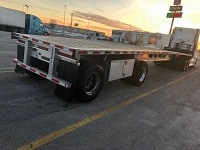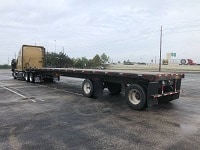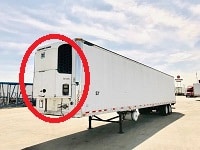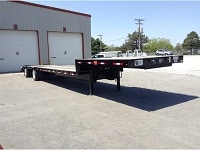 What is a flatbed truck? A flatbed truck is a truck that is hauling a trailer that is flat. The trailer has no walls or roof, and the trailer is usually made out of durable wood. A flatbed truck is used for hauling freight that is usually over sized due to the flat style and open concept with the trailer.
What is a flatbed truck? A flatbed truck is a truck that is hauling a trailer that is flat. The trailer has no walls or roof, and the trailer is usually made out of durable wood. A flatbed truck is used for hauling freight that is usually over sized due to the flat style and open concept with the trailer.
A flatbed trailer is usually forty-eight feet long, but they can be as long as fifty-three in length as well. Below is a picture of a typical flatbed truck.

The width of a flatbed trailer is eight feet and six inches or 102 inches in width, and this is the legal maximum width.
There are larger widths flatbed trailer, but those flatbed trailers would require a permit in the United States as they are considered a “wide load”.
The freight that a flatbed truck usually carries is heavy equipment, construction equipment, metal, and many more items that can’t fit in a dry van trailer.
What is the Difference Between a Flatbed and a Dry Van Trailer?
A flatbed and a dry van trailer are the two most popular trailers being used on the highways currently in the United States.
What are the main differences between the two? I wrote an article detailing exactly what dry van trailers are, you can read it right here.
A flatbed trailer has many different options for hauling a variety of freight.
They are perfect for oversized objects such as large machinery, metal, and much more. Often these items cannot be placed in a dry van trailer.
The flatbed trailer has no sides or a roof, so a forklift is often used to load or unload freight from the flatbed trailer because it can assess the flatbed from the side too.
One of the downsides with a flatbed trailer is the freight is not protected from the weather elements. The driver of the flatbed is responsible for tarping (covering) the freight from the elements but if the weather turns then there is sometimes nothing the driver can do to keep it dry.
What about the dry van trailer?
A dry van trailer is completely enclosed as it has walls and a roof so weather won’t effect the freight very much at all.
A dry van trailer is the most popular trailer for hauling commercial freight, electronics, and freight that needs protection.
They can be loaded and unloaded at the rear of the trailer only because it has solid walls.
The freight can be removed or added to the dry van trailer by using a pallet jack or a forklift. In this case the forklift drives into the dry van in order to pickup the freight and remove it but cannot access it from the sides.
What is the Difference Between a Flatbed and a Reefer Trailer?
A reefer trailer is more similar to a dry van trailer than a flatbed.
The reefer trailer is a temperature-controlled trailer, which is excellent for products that need constant refrigeration.
A reefer trailer is basically an insulated dry van trailer with a refrigeration unit on it to control the temperature inside the trailer.
Here is a picture of what the reefer trailer looks like, notice the refrigeration unit attached to it:

A flatbed trailer is an open trailer without the walls and roof. The freight is not protected from the elements until the driver tarps the freight to keep it from rain and snow.
The flatbed trailer is perfect for large machinery, construction equipment, landscaping materials, and very large items that needs transported.
What is the Difference Between a Flatbed and a Step Deck Trailer?
A step deck trailer is very similar to a flatbed trailer. They both have a have a flatbed trailer, but the step deck trailer has a top and bottom deck that the flatbed trailer doesn’t have and sits lower to the ground so that it can carry taller freight.
A step deck trailer can haul freight that is over nine feet tall, and no permit is needed with a step deck trailer due to the fact that they sit lower to the ground and stay within height restriction laws.
Most step deck trailers also have ramps attached to the back of the trailer, which is used to drive machinery onto the trailer, and flatbed trailers doesn’t have the ramps either.
Here is a picture of a common step deck trailer, notice how much lower it is to the ground than a flatbed:

What Makes Driving a Flatbed Unique?
A truck driver that drives a flatbed usually makes a higher wage, because driving large freight on the flatbed trailer can be dangerous and requires more work than driving a dry van or reefer.
The truck driver will also have regular exercise, because the driver has to tie down their loads with straps and sometimes with tarps.
If the freight needs to be protected from dirt or even fumes from the exhaust, they will request the load be tarped, and the driver will get paid extra for that too.
Tarps can weigh eighty pounds and more, and if it has been raining or snowing, then the tarps are heavier.
Flatbed driver get their workout in every time they have to tarp and tie down a load.
Another plus to being a flatbed driver is that you will usually drive during the daytime, because most receivers with large freight are only open during the daytime, so the driver will rarely drive during the night.
A flatbed driver will also spend less time being loaded and unloaded while dry van trailers can take more time when they are being loaded or unloaded.
This is great because you will have less wasted time waiting for a load while your hours are running.
What Do Flatbed Trucks Carry?
Flatbed trucks usually carry numerous items, which include:
• Scrap Metal
• Construction Materials
• Baled Tires
• Tractors
• Farm Equipment
• Tow Trucks
• Heavy Equipment
• Landscaping Materials
• Bulk Containers
• And many more items…
What Are Flatbed Truck Dimensions?
The standard flatbed trailer is usually forty-eight feet long and eight feet and six inches wide. There are some flatbed trailers that are fifty-three-foot-long, but they aren’t used as often as the standard flatbed trailer.
How Wide is a Flatbed Truck Bed?
The standard flatbed truck bed is eight feet and six inches wide. There are wider width flatbed trailers, but they would require a permit in the United States.
Do Flatbed Drivers Make More Money?
Yes, flatbed truck drivers make more money than drivers that have a dry van or refrigeration trailer.
Usually, a flatbed truck driver will make ten to fifteen cents per mile more than a dry van or refrigeration driver.
Much of this difference is pay is because the flatbed driver has to tarp (cover) and tie down (with straps) the freight, this requires quite a bit more physical work than non flatbed drivers.
Dry van and reefer drivers don’t have to tarp anything, their trailer is loaded and they are one their way.
What is Tarping in Trucking?
Tarping in the trucking industry means freight needs to be protected from the weather elements, dirt, and fumes from the exhaust.
There are different types of tarps that are used for different freight, and they include:
• Lumber Tarps
• Coil Tarps
• Smoke Tarps
• Steel Tarps
Tarps are heavy as they weight nearly eighty pounds. If the tarp has been rain, snow, or ice, then the weight is more.
Tarping is one of the hardest parts for a flatbed truck driver because it requires a lot of physical work.
Final Thoughts About The Flatbed Truck
A flatbed truck is similar to a dry van or refrigeration trailer, but it doesn’t have a roof or sides.
A flatbed trailer is used to haul freight that is large and bulky such as farm equipment, building supplies, and other large items.
A flatbed truck driver does make more money that the average truck driver, because there is a lot of physical activity involved in making sure the freight is secure, and it is more dangerous to drive a flatbed truck.